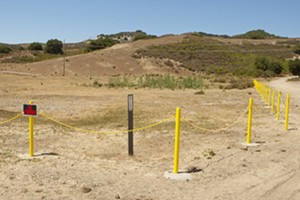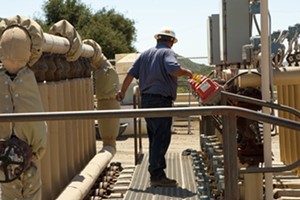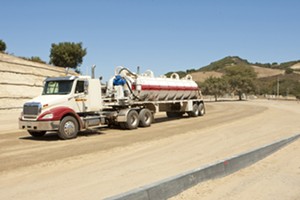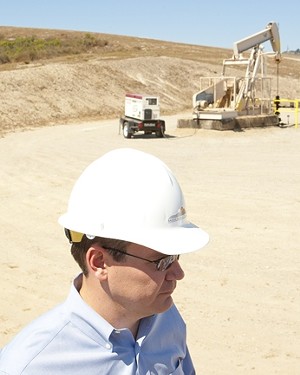Santa Maria Energy spokesman Bob Poole and production manager Kevin Yung stand side by side on a grassy hillside overlooking the Orcutt Oil Field, admiring the view.

The vista before them reveals a land of many uses; traditional “grasshopper” pumps and steam injection wellheads coexist alongside vineyards, herds of cattle, and neighboring oil company Pacific Coast Energy.
From their perch, the cycle of the steam procedure the company employs, also known as “huff and puff,” is readily evident. Reclaimed water is trucked in, heated with a generator, and sent through various pumps and pipelines. The resultant steam is pressurized and injected into oil deposits more than 1,000 feet below in primordial seas.
The focus of the drilling operation is two massive oil reserves of diatomite and Monterey shale. The heat soaks the rock, making the oil inside more viscous and easier to trap, Yung explains. Through the process, Santa Maria Energy extracts about 500 barrels each day, roughly equally between the two formations. Large tanks separate the oil and gas from the water, and the finished product is trucked out to the ConocoPhillips refinery in Nipomo.
Oil production on the Central Coast is certainly nothing new; in fact, it began way back in the early 1900s. Companies like Chevron and Shell abandoned the fields when drilling was no longer profitable, leaving much of the unreachable deposits behind.
“There’s a lot of oil down there,” Poole says. “We’ve known about it for a long time; we just couldn’t get to it.”
Today, a combination of technology and economics is making production feasible again, and Santa Maria Energy is finding success using steam in the diatomite, a porous, oil-saturated rock made of fossilized algae. The National Energy Technology Laboratory estimates between 12 and 80 billion barrels of oil might still be locked in California’s diatomite, and a lot of it is in Santa Barbara County—four to 15 billion barrels, to be exact.
Santa Maria Energy’s pilot project has proven successful enough to expand it; the company envisions upping the number of steam wells dramatically from 26 to 136, built out over the
course of the next five years.
Poole explaines his company is taking a novel approach to drilling, producing oil while remaining stewards of the environment. Upon entering the fields, one notices a breeding pond for tiger salamanders, and habitats for endangered plants clearly marked and fenced off. Nearby, the company is growing oak trees to replace any it might need to remove.
“We choose to do business here in Santa Barbara County because our business model supports it,” he says. “If you want to be on the cutting edge, this is where you want to be.”
A new liquid gold rush?

Let’s face the facts: Barring a complete overhaul of American society or a miracle breakthrough in energy, oil isn’t going away anytime soon. It’s in the cars we drive, the clothes we wear, and in the smartphones and computers we depend on for communication.
According to estimates from the U.S. Energy Information Administration, the United States consumes about 20 million barrels of oil each year, and despite ongoing research into alternative fuels, the administration predicts by 2035 Americans will require more oil—not less—than we do today.
The problem, explained Poole (who also happens to drive a Prius), is an inherent disconnect between American energy demands and the “wishful thinking” of oil independence.
“We’re still going to be needing that oil, so why are we getting it from somewhere else?” Poole asked. “We’ve got the resources right here in this county. We can drill enough to buy us time to continue to bring in other sources of energy.”
According to California’s Division of Oil, Gas, and Geothermal Resources (DOGGR), statewide production has fallen to 500,000 barrels per day, half the peak reached in the 1980s. Offshore production is declining as well.
Santa Barbara County is home to 25 known onshore oil fields, and about 13 are active producers. DOGGR figures show onshore production in the county has jumped 12 percent from 2001 to 2011, to nearly three million barrels a year. Four fields have seen significant increases in the last decade—Careaga Canyon is up about 250 percent—but offshore production has dropped 33 percent over that time. Overall, the county is producing slightly less oil than it did a decade ago.
The county is home to about 20 operators with active leases, including Plains Exploration and Production, Venoco, HV1 Cat Canyon (formerly Greka), and Pacific Coast Energy (formerly BreitBurn) producing 9,000 barrels a day from 935 wells. If Santa Maria Energy’s expansion goes through, the company projects it would increase the county’s total production by one third, to 12,000 barrels a day.
Santa Maria Energy isn’t the only oil company with designs on expanding operations in the Santa Maria Valley. Some industry analysts are going so far as to predict that the Central Coast might be in for a second “gold rush,” this time with oil.
With demand increasing and the economy lagging, the time seems ripe for a rebound. Doug Anthony, deputy director of Santa Barbara County’s Energy Division, reports the county is seeing a flurry of activity in new permitting applications, driven by the rising price of crude oil.
“With the higher prices there is now incentive to go after the resources onshore,” Anthony said. “We’re seeing a resurgence that is keeping us busy, which is good.”
In the last three years, more than 40 projects have been proposed for onshore oil fields. Other companies applying to expand their operations, Anthony said, include Petro-Rock, which is seeking to add more than 50 steam injection wells near Garey; Underground Energy in Zaca Oil Field; and ERG Resources in Cat Canyon.

“I think we would have a lot of new development,” Anthony said. ”They definitely have the investors. We’re moving forward.”
Pacific Energy spokesman Jim Bray, whose company produces about 2,800 barrels a day in the Orcutt field, said his company has no plans to grow at the moment, but the potential remains.
“We think there is a significant amount of oil still left here to produce,” Bray said.
Besides pricing, there’s another reason for increased focus on the Central Coast: Monterey shale. The Monterey is a rock formation running deep under the state, passing directly under Santa Barbara County. It’s been developed for more than a century, but enhanced drilling technologies—steam injection, directional drilling, and hydraulic fracturing— have increased production and decreased costs.
The U.S. Energy Information Administration estimates there might be as much as 15.42 billion barrels of recoverable oil in the formation, making it the largest oil “play” in the country.
“That’s a lot of oil,” said Tupper Hull, spokesman for the Western States Petroleum Association, a Sacramento trade group representing the major oil companies. “That could be a game changer for the state’s energy security, should it be developed at that level. It could replace all of our foreign imports of oil for the next 40 or 50 years.”
Despite the potential, Hull said, the number of wells drilled and permits issued statewide is actually substantially down in 2012 when compared with last year, and Hull isn’t optimistic about a rebirth on the Central Coast.
“We certainly don’t see any indications that there’s a boom coming,” Hull said. “The thought that you would see a sudden and rapid increase in oil production given all of the regulations and obstacles that exist here is pretty hard to imagine.”
California is a challenging place for permits, Hull explained, but especially in Santa Barbara County, where residents are “highly skeptical” about increasing energy development, in large part due to the disastrous 1969 Santa Barbara oil spill.
“It’s the only county in California with an energy department with jurisdiction over some aspects of oil production,” he said. “There’s no question [the ’69 spill] was a watershed event, and I think it’s still safe to say it’s a major factor in the community’s approach to energy production.”
Permitting, permitting, permitting
The oil companies appear determined to take politics out of the permitting equation. Santa Maria Energy president David Pratt blames “merchants of misinformation” for spreading erroneous information about the oil industry, leading to “bad public policy.”

“There is a distinct minority in the county who are very well organized and intent on usurping private property rights and using environmental laws to do it,” he said. “You tend to fear what you don’t understand, and the oil industry does a piss-poor job of public relations.”
The biggest public misconception, Pratt explained, is thinking all oil companies are the same, equating them with disasters such as the ’69 spill, the Exxon Valdez spill, and the Deepwater Horizon explosion in the Gulf of Mexico.
“The fact is if you sum up all the spills compared to the number of barrels produced successfully, oil
has an extraordinary track record,” Pratt said.
In Santa Barbara County, any type of drilling requires a trip through the California Environmental Quality Act (CEQA) process, and a zoning change, land use permit, or a comprehensive oil development production plan. Anthony said while it’s true the county has more regulations than say, Kern County, there are multiple factors involved.
The county’s designated oil fields happen to be located in the epicenter of tiger salamander and red-legged frog habitats, he said, which must be mitigated.
“If we’re going to successfully get somebody through a permit process, we have to make sure we’ve addressed any potential impacts to those species, or we’ll get appealed and sued based on inadequate review,” Anthony said.
Complicating matters is the fact that mineral rights are not always tied to surface property rights, which has also caused permitting headaches. Recently, Anthony said, oil companies have found success bringing agents to work with issues up front, qualifying them more often for the over-the-counter permits.
Enhanced drilling techniques, such as water flooding, steam injection, or hydraulic fracturing, automatically trigger an oil development production plan, which requires an environmental review and can take years and cost millions of dollars to complete. The process isn’t only costly, but also risky; even with the time and money invested, there’s no guarantee drilling can commence. Permits are discretionary and can be appealed to the Board of Supervisors.
Poole calls Santa Barbara County’s drilling regulations “the most stringent in the world,” but when it comes to his industry’s concerns, it’s not about relaxing regulations; it’s about a need for certainty and predictability in the process.
“We should be allowed to do a project without it being motivated by a political agenda,” Poole argued. “We’re fine with the environmental regulations—we’re over-complying with some of them—but let us do our project. Let us work under the same rules.”
Of course, not everybody thinks expanding onshore development would be in the county’s best interest. The Environmental Defense Center’s staff attorney Nathan Alley argues more activity means more emissions, both of the greenhouse gas variety and general pollutants. Furthermore, communities located near existing or historical oil fields are now raising concerns about their peace and quiet being interrupted.
“Many of these people purchased land knowing exactly what was there and what they might be getting into,” Alley said. “But I believe, in talking to a number of people, this idea that we’re going to see a new large-scale resurgence of oil development in the North County frightens some property owners.”
It’s the economy, stupid

With the local economy and employment lagging, groups like the Economic Alliance of Northern Santa Barbara County are pushing for more onshore drilling to boost local coffers and create more higher-paying jobs.
In the eyes of oil proponents, increasing production could save both the county and the state financially. Besides generating 1.4 million jobs in California by developing Monterey shale—according to the U.S. Department of Labor—it could make the country and region energy independent, supporters claim.
Currently, according to the U.S. Energy Information Administration, nearly half of California’s oil comes from foreign countries, areas that also happen to be located in the world’s political trouble spots.
“For every barrel of oil we produce domestically, that’s one less barrel we need to import,” explained Pacific Coast Energy’s Bray. “Not only is it more production and more tax revenue, but it’s very good paying industry jobs, and jobs for the contractors we hire here locally.”
Santa Maria Energy currently employs about 36 workers, and
Poole said the proposed expansion project could create 100 more jobs, as well as add $3 million to the local economy in property taxes. Oil and gas ranks near the top among industries in county property tax revenue, with more than $8 million paid out last year.
On the flip side, environmental activists like the Environmental Defense Center believe the potential benefits aren’t worth the cost. While drilling may help the economy in the short term, Alley said efforts should be focused on shifting to more renewable sources of energy.
“My vision for the future is that when we make the transition … it will be a job generator,” Alley said. “I certainly do hope that our economy improves, and that unemployment rates continue to drop, but we can’t do it in ways that are going to hurt everybody else.”
According to Alley, the oil industry’s claim that the region could become oil independent from more drilling is a fallacy. Oil produced locally is eventually shipped off to Los Angeles and San Francisco, he said, where it enters the global market and can end up anywhere.
“The argument about domestic energy independence is really evocative and compelling, but the reality is that it’s not probably our future,” he said.
Fear of ‘fracking’
Spurred by the documentary film Gasland, hydraulic fracturing—or “fracking” as it’s commonly called—has raised nationwide concerns that the practice might lead to groundwater contamination and contribute to earthquakes.
In the hydraulic fracturing process, wells are first drilled vertically about 5,000 feet deep, then horizontally, and a highly pressurized mixture of water and chemicals is sent through the wellbore to rupture the rock, releasing the oil contained inside.
Contrary to popular belief, hydraulic fracturing is not a recent development; it’s been in use for more than 60 years. What is newer is the concept of combining the process with horizontal drilling, and the application of chemicals—the exact content of which remains a trade secret—to soften the rock.
Amid calls by legislators to ban the practice in California, on July 25, protesters demonstrated against fracking outside the California Environmental Protection Agency headquarters in Sacramento, where DOGGR was set to hold a public workshop on the practice. Another meeting was held in Santa Maria on July 11.
[image-6]
Discussed during the meetings were the actions of Denver-based oil company Venoco, which raised eyebrows last year by fracking two wells near Los Alamos without the knowledge of county officials. The county’s Board of Supervisors responded swiftly, deciding in December 2011 that companies planning to use the practice would have to apply for a stricter production plan.
Sparked by Venoco’s fracking, Santa Barbara surfer Chadd Konig, 24, decided to do something about it. For the past several weeks, he’s been paddling on his surfboard along the 250-mile coastline from Santa Cruz to Santa Barbara to raise awareness of fracking on the Central Coast. Reached by the Sun during a break, he called the technique’s threat to groundwater the “most current, relevant, and threatening” issue facing the state, and said he’s using his journey as a medium to voice his concerns.
“Right now everyone’s just kind of in the dark,” Konig explained. “The public should know what’s going on in their towns. They should know what could potentially happen to their groundwater, what could happen to their land as far as earthquakes.”
Konig said he understands the realities regarding oil consumption and demand, but a return to oil development will only allow for renewed acceptance. The risk, he said, isn’t worth delaying oil’s inevitable end.
“I don’t see it benefiting our state,” Konig says. “They say it will create all these jobs, but are they safe jobs? Think of your wife or a family member working for one of these companies; are you going to want them around all those chemicals?”
DOGGR is currently developing state regulations on hydraulic fracturing, which it hopes to have in place in 2013. While the Environmental Defense Center and others are happy to see the state tackle the issue, they’re concerned regulations could trump local efforts.
“We’re saying, ‘Whatever you do, don’t step on the toes of the local people,’” Alley said. “They’re the ones who have the eyes on the ground and the experience to know how to deal with these projects.”
The debate over fracking could end up being a moot point in Santa Barbara County. As it turns out, the experiment by Venoco in Los Alamos proved unsuccessful, and the company is currently in the midst of a go-private transaction, spokesman Mike Edwards said. The county Energy Division’s Anthony said, as a result, it’s possible companies are moving away from the practice, at least locally. First of all, he explained, hydraulic fracturing is expensive, and secondly, some companies are deciding it’s unnecessary with shale.
Western State Petroleum Association’s Hull concurred. Though hydraulic fracturing has proven effective in other parts of the country with natural gas, he said, it hasn’t shown much promise in California because of the nature of state’s geology.
“There’s certainly an interest in seeing whether hydraulic fracturing and directional drilling can be effective at developing the Monterey shale more extensively than it has been developed to date,” Hull said. “But the jury is still out.”
Oil and the environment
Santa Maria Energy currently doesn’t perform hydraulic fracturing and has no plans to, though officials do see the procedure as safe and efficient.
“We don’t have to do it right now,” Pratt said. “We have enough political battles to fight.”
The technique Santa Maria Energy is using, cyclic steam injection, has been around since at least the 1920s, though its use with diatomite is fairly new.
The Environmental Defense Center is concerned about steam injection’s potential for water contamination, and the use of large amounts of water that could otherwise be used for irrigation or drinking. However, Santa Maria Energy officials point out their water is reclaimed, and has been obtained from treatment plants.
The center is awaiting results of the environmental review for the project, which could come as soon as the end of August. While the group isn’t taking an official position on the expansion, it is in discussion with groups about its potential impacts, particularly the 85,000 metric tons of greenhouse gases the county says the expansion would create annually.
“That obviously is a very large amount, much larger than most sources we see here in the county,” Alley said. “We’re hoping [the county] will essentially try to get Santa Maria Energy to mitigate or avoid most of those emissions, but it’s probably going to be something of a case study in Santa Barbara County.”
Santa Maria Energy is the first company in Santa Barbara County to seek a drilling permit under AB32—the state’s greenhouse gas emissions law. According to Anthony, applying the law to oil operations and figuring out what level of emissions constitutes a significant contribution has presented a challenge.
“It’s been a head-scratcher,” Anthony said. “Though the state says we have to do this stuff, they haven’t provided a whole lot of guidance about how to go about doing it. It’s more than just disclosing, so that’s been difficult for us.”
For now, the water Santa Maria Energy uses is trucked in from the Laguna County Sanitation Department. As part of its proposal, the company wants to tap into an already existing pipeline and funnel water to the site through an eight-mile extension paid for by the company and handed over to the county.
The pipeline would remove trucks from the road, Poole explained, and, therefore, lessen emissions. An existing flare that burns off the gas used to heat the steam will also be removed, he said.
As a pioneer of AB32, Poole said the company is confident it can not only match the carbon dioxide reductions required, but also exceed them.
“We don’t have anything to hide,” Poole said. “What we bring is a significant economic benefit, while helping us reach broader goals of energy independence. Why don’t we do it? It seems like a no-brainer to me.”
Contact Staff Writer Jeremy Thomas at [email protected].








